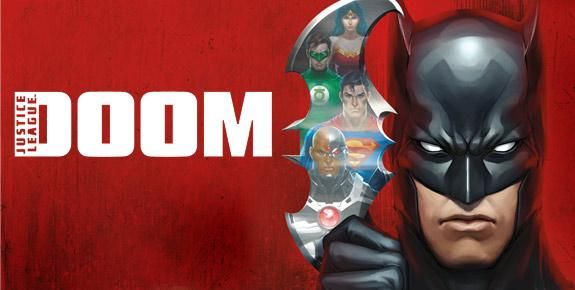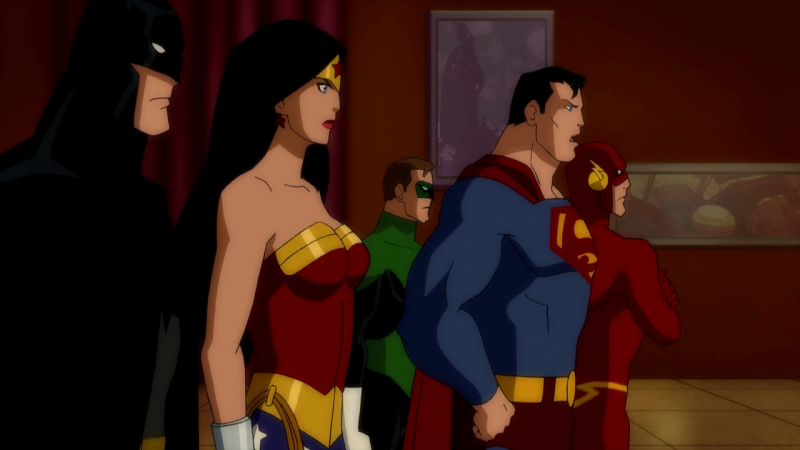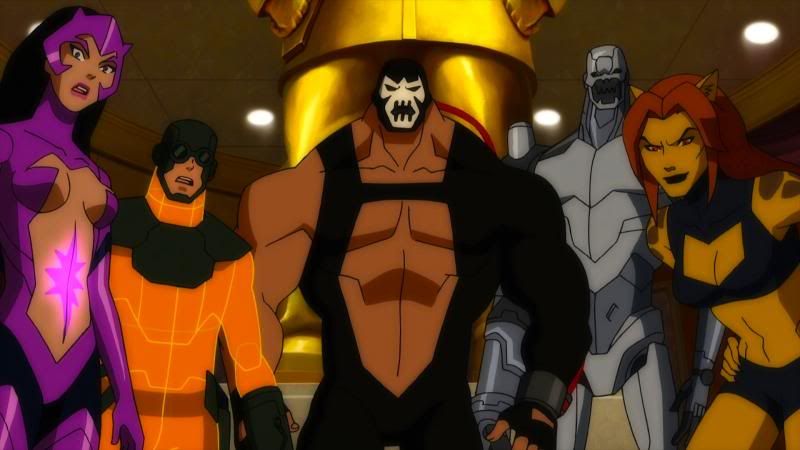Even when I was younger, I knew there was something that set Batman: The Animated Series apart from other cartoons. At the time I chalked it up to visual style – the black cels really sold the noir asthetic of Gotham. However, looking back, the writing is incredibly solid and often goes to dark places for what is obstensibly a children’s program. I haven’t watched a great deal of the Justice League or Justice League Unlimited series, but after watching Justice League: Doom instead of shelling out for Injustice: Gods Among Us, I may have to correct that oversight.

Batman is, as a rule, paranoid. He’s a very rich man with a very odd nightlife and some very interesting friends, ranging from nigh-invincible aliens to smart-alec test pilots with magic jewelry. He knows for a fact that they’re good people, these friends of his, but he also knows that good people can be mislead, controlled, manipulated, or even turn bad. So he has plans for dealing with each and every one of these friends. Now what, do you suppose, happens when these plans get stolen, cranked up, and unleashed on Batman and his friends in the Justice League? This is the brainchild of immortal douchebag Vandal Savage and his newly forged Legion of Doom.
What Justice League: Doom does right is taking the focus away from major super-powered threats or earth-shattering kabooms. The scope of this film is a lot smaller, its tone more intimate, than most stories that deal with super-heroes, especially teams. With animated features, where special effects are less limited by things like budget, the temptation can exist for a creative team or vision to override more character-focused story points. Thankfully, Doom does not fall into that trap. For most of its running time, we see how Batman’s contingency plans wreck havoc in the lives of his teammates. And since the plans are meant to deal these super-powered individuals on both a physical and a psychological level, the plans can be rather insidious, and make for good watching.

The art style is crisp but may seem too childish or anime for some.
The nature of the conflict is matched by good pacing and excellent voice work all around. Both Kevin Conroy and Tim Daly reprise their long standing roles as Batman and Superman, respectively. I happen to like Hal Jordan as Green Lantern, and Nathan Fillion supplying the voice was a great bonus. With this core of talent, the characters really come to life. This helps drive home some of the moments that could define, or destroy, these heroes. There’s also the fact that many of those moments go to very dark territory. We have bombs bolted to people’s bodies, live burials, major psychological trauma, and even people getting shot point-blank in the chest. It’s clear from the outset that this story isn’t messing around.
Unfortunately, Justice League: Doom is not perfect. The nature of the Legion of Doom’s formation means that each member other than Savage has a personal beef with an individual hero on the Justice League, and pairings pretty much remain fixed throughout the final battle. For example, Mirror Master might have given Superman a run for his money, and how would Metallo fare against Green Lantern? Another problem is in said final battle; since the plans are resolved as a prelude to said battle, most of the interesting character points have already happened or are largely inconsequential. It feels a great deal like the final minutes of Justice League: Doom simply run out of steam, which is a shame considering it’s good opening and fantastic second act.

I really like Mirror Master’s design. The see-through look nails the character.
Stuff I Liked: The implementation of the plans to take out the Justice League. I liked seeing these versions of Bane, Star Sapphire, Metallo, and particularly Mirror Master. Batman revealing he’s always got kryptonite available made me grin like an idiot.
Stuff I Didn’t Like: Vandal Savage is perhaps my least favorite kind of villain: he’s evil for evil’s sake. His plan is megalomaniacal in the extreme and he has only the most paper-thin of excuses for carrying it out. I’m still not a huge fan of Superman; it seems difficult for a given writer to decide just how much power kryptonite has over him or how long it takes for the glowing rocks to weaken him.
Stuff I Loved: The voice acting is very good. There’s a moment about halfway through involving Cheetah and Vandal Savage that really impressed me with its audacity. I’m not too ashamed to say I enjoyed Superman getting shot. Hal Jordan remains my favorite Green Lantern, and having him voiced by Nathan Fillion was a great moment of fanboy enjoyment for me.
Bottom Line: For all of the imperfections I saw emerging, Justice League: Doom still tells a decent story and inhabits some of the more fantastical characters of the DC universe with some humanity and vulnerability. As good as it could have been with some elements mixed a bit more and a couple more chances taken, what it does is done well.



April 18, 2013 at 8:55 am
So, yes, you should totally, totally watch JLA and especially JLU. The quality is pretty amazing all around.
There’s one other thing that is noteworthy about Doom which, in my mind, makes up for some of the tone shift in the end, and that’s the role of Cyborg. Historically, he has either not been a member of the league at all or, when a member, has been so profoundly token as to be basically taking up space. Some of this was a result of tokenism, but it also was a bit of the aquaman problem – you might be super, but the guys you’re standing next to make it hard for that to seem noteworthy.
I mention all this because this was probably the best presentation of Cyborg I’ve ever seen, and it was done in such a way that it did not feel forced (to me). His powers, capabilities and role fit the situation very naturally, and his role in the final conflict was satisfying. That was a big check in the plus column for me (and was not a big shock when I realized the late Dwayne MacDuffie was a big brain behind this).
Interesting bit of trivia: In the comic book arc this is derived from, the villain is Ras Al Ghul, and while his endgame is comparably super-villainy, it’s very consistent with the character. However, it would have been much harder to shorthand than Savage’s survival of the fittest canned villainy.